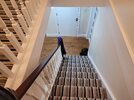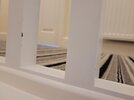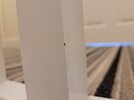Wondered if any of you experienced decorators may be able to help.
Backstory:
I had a staircase, all made of teak and stained/oiled.
I had the whole staircase sanded back to bare, the handrail was then oiled/stained, but we had the spindles and all surrounding woodwork painted with Dulux satinwood.
Issue
Each month I would see a tiny bit of paint peel off the bottom of one of the spindles (it was not being knocked as it was the opposite side to the landing spindles) the paint would then flake off and is very noticable as it's dark.
I thought it just hadn't taken in certain sections. I'd sand it back, prime and paint the spot, but more came again several weeks later and this went on for 8 months.
What is weird is all the other paintwork surrounding it had no problems at all and for some reason the upstairs ones are "more" prone to this blistering.
. The decorator's we use are good and couldn't understand why it was happening and is coming back but I am wondering if there is any additional preparation or a better product?
Procedure:
Sanded back to bare, blocker applied (I believe Zinsser bin), it was then primed and then painted with Dulux satin wood.
I've attached some pictures as an example, I managed to actually get a picture of one where you can actually see the flaking of the paint.
There are prior areas that you can see I have touched in prior, ( I didnt' go back to do subsequent coats)
What is odd is that underneath the colouris still dark, but I watched them sand it bare, so would expect the lighter wood colour, which I see if I sand that bit down. I was asking a friend about it and he stated it could be the oils that it was coated with still seeping back out and causing these spots?
Any one have any ideas or suggestions to ensure this doesn't happen again? The decorator is going to come back and sand it all back again (unless it's firmly stuck), block, prime,paint
Backstory:
I had a staircase, all made of teak and stained/oiled.
I had the whole staircase sanded back to bare, the handrail was then oiled/stained, but we had the spindles and all surrounding woodwork painted with Dulux satinwood.
Issue
Each month I would see a tiny bit of paint peel off the bottom of one of the spindles (it was not being knocked as it was the opposite side to the landing spindles) the paint would then flake off and is very noticable as it's dark.
I thought it just hadn't taken in certain sections. I'd sand it back, prime and paint the spot, but more came again several weeks later and this went on for 8 months.
What is weird is all the other paintwork surrounding it had no problems at all and for some reason the upstairs ones are "more" prone to this blistering.
. The decorator's we use are good and couldn't understand why it was happening and is coming back but I am wondering if there is any additional preparation or a better product?
Procedure:
Sanded back to bare, blocker applied (I believe Zinsser bin), it was then primed and then painted with Dulux satin wood.
I've attached some pictures as an example, I managed to actually get a picture of one where you can actually see the flaking of the paint.
There are prior areas that you can see I have touched in prior, ( I didnt' go back to do subsequent coats)
What is odd is that underneath the colouris still dark, but I watched them sand it bare, so would expect the lighter wood colour, which I see if I sand that bit down. I was asking a friend about it and he stated it could be the oils that it was coated with still seeping back out and causing these spots?
Any one have any ideas or suggestions to ensure this doesn't happen again? The decorator is going to come back and sand it all back again (unless it's firmly stuck), block, prime,paint




